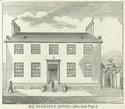 There was a great expansion of activity during this period. In 1783 John Smith Junior had a circulating library of 5,000 volumes as an adjunct to his famous bookshop in the Trongate. He had a competitor in the High Street in Archibald Coubrough who had 4,500 volumes available for loan. By 1800 Glasgow had at least four circulating libraries. The city belatedly got its first subscription library in 1791 when Walter Stirling, a businessman and magistrate, left his books to Glasgow. As there was not enough money to maintain the library it was decided to run it by subscription. It soon found a rival in the Glasgow Public Library, begun in 1804, which had a children's section, probably Glasgow's first children's library.
There was a great expansion of activity during this period. In 1783 John Smith Junior had a circulating library of 5,000 volumes as an adjunct to his famous bookshop in the Trongate. He had a competitor in the High Street in Archibald Coubrough who had 4,500 volumes available for loan. By 1800 Glasgow had at least four circulating libraries. The city belatedly got its first subscription library in 1791 when Walter Stirling, a businessman and magistrate, left his books to Glasgow. As there was not enough money to maintain the library it was decided to run it by subscription. It soon found a rival in the Glasgow Public Library, begun in 1804, which had a children's section, probably Glasgow's first children's library.
 During the 1790s Glasgow had some fourteen temporary reading societies, many inspired by the political agitation of the period. William Gillespie's cotton mill in Woodside had a library for its workers in 1796 and a similar one existed at the Barrowfield Print Works in 1824.
During the 1790s Glasgow had some fourteen temporary reading societies, many inspired by the political agitation of the period. William Gillespie's cotton mill in Woodside had a library for its workers in 1796 and a similar one existed at the Barrowfield Print Works in 1824.
 Until the beginning of the 19th century the working classes had usually controlled the libraries they used, but now the middle classes began to intervene to manipulate working class book use. This took the form of utilitarian education (mechanics institutes with associated libraries) to promote part time vocational education on the model of Anderson's Institution, founded in 1796. By the 1820s there were three mechanics institutes of which the Glasgow Mechanics' Institution in Bath Street, founded in 1823, had the largest library.
Until the beginning of the 19th century the working classes had usually controlled the libraries they used, but now the middle classes began to intervene to manipulate working class book use. This took the form of utilitarian education (mechanics institutes with associated libraries) to promote part time vocational education on the model of Anderson's Institution, founded in 1796. By the 1820s there were three mechanics institutes of which the Glasgow Mechanics' Institution in Bath Street, founded in 1823, had the largest library.